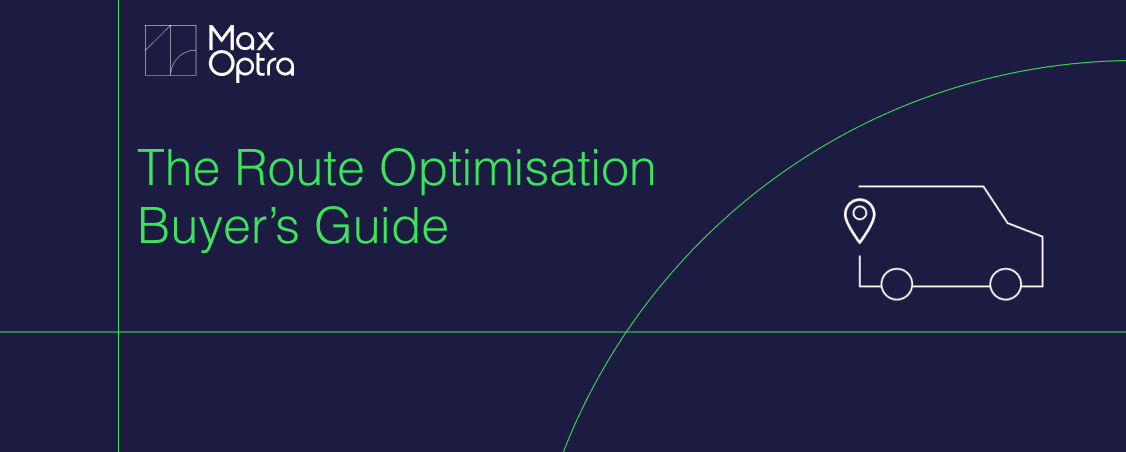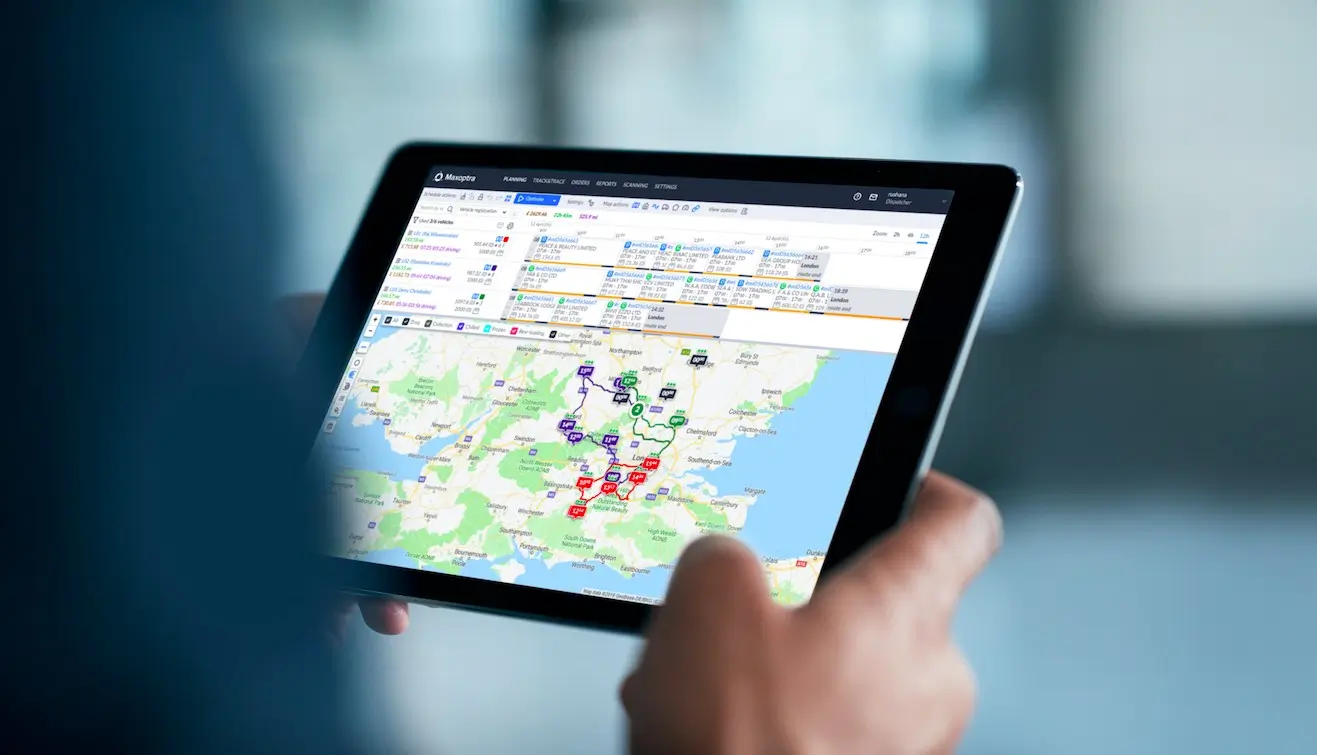The Route Optimisation Buyer’s Guide

Are you finding yourself struggling to manage an ever-expanding logistics operation?
Are you looking for ways to optimise your transport processes and improve efficiency, reduce costs, and save time?
Route optimisation is a powerful tool that can help you take control of operations whilst boosting productivity. With the right approach, route optimisation can have an enormous impact on your bottom line.
This comprehensive guide looks at the essential elements of route optimisation in order to help businesses select the best system for their unique needs.
From cost considerations, hardware requirements and software capabilities; by the end of this guide you’ll be equipped with all the knowledge necessary to make informed decisions about investing in the right route optimisation technology.
What is Route Optimisation?
Route optimisation is the key to the smooth running of any delivery offering, for both B2B and B2C businesses.
It refers to the process of ensuring delivery drivers are making the fastest, safest, and most efficient routes so they can successfully deliver to multiple destinations, on time, during their day.
Route optimisation software enables this by planning routes daily, weekly, monthly, or however frequently you require your dynamic schedule. The algorithm in the software produces efficient and reliable routes, fast. Taking into account traffic conditions and known roadworks, as well as vehicle capacities, live order volumes and delivery time windows.
All of this supports businesses in avoiding any potential inefficiencies of fixed routes, reduces excess mileage, keeps your customers happy and, as a result, cutting operational costs by up to 20%.
The benefits of Route Optimisation Software
Cost reduction and time savings
One of the major benefits of using route optimisation software is that it leads to significant cost reduction and time savings in your logistics process.
By finding the most efficient routes and providing real-time updates on changes in traffic conditions and weather, the software minimises time and fuel consumption, ultimately lowering your operational costs.
These savings can then be allocated to other parts of your business, allowing for greater investment, growth and higher profit margins.
Improved customer satisfaction
In today’s fast-paced world, customers expect timely and accurate deliveries.
Route optimisation software reduces overall delivery times by taking into account multiple factors such as traffic, road conditions, and order volume, so drivers can reach their destinations on time. This not only helps in maintaining a positive brand reputation, but also increases the likelihood of customer retention and generating positive word-of-mouth.
Furthermore, this software can provide customers with real-time tracking and accurate ETAs, enhancing their overall experience as they feel more involved and informed during the delivery process.
Enhanced driver safety and compliance
Route optimisation software includes features that enable transport managers to monitor driver behaviour, analyse their performance, and ensure they comply with the required safety and service standards.
This includes providing the most appropriate routes that comply with speed limits, weight restrictions, and other safety requirements.
As a result, drivers have less risk of getting into accidents or violating traffic laws, which could ultimately save your company from fines, damage to vehicles, or increased insurance premiums.
Streamlined planning and performance metrics
With route optimisation software, logistics managers can easily plan routes for multiple vehicles by assigning the best, most efficient routes to ensure their fleet is working at the optimum level.
In addition, the software’s reporting tools provide valuable insights and analytics regarding various performance metrics such as on-time delivery rates, distance travelled, fuel consumption, and driver productivity.
These insights can help you make data-driven decisions to optimise your logistics operations further, maximising efficiency and profitability.
Adapting to dynamic conditions
Route optimisation software enables logistics managers to adapt to diverse and dynamic conditions such as increased order volumes, unexpected roadblocks or detours, and last-minute order changes.
By swiftly recalculating the optimal route based on these changes, your company can avoid delays or disruptions efficiently.
This flexibility can be the key differentiator for your business, giving you an edge in a competitive market where the ability to adapt quickly can prove critical to success.
Challenges in Route Optimisation
Complexity of the road network
One of the major challenges in route optimisation is the complexity of the road networks themselves.
In urban areas, the high density of roads, traffic congestion, and one-way streets can complicate the routing process. Additionally, considering the dynamic nature of factors such as road works, closures, and other disruptions can pose an even greater challenge for logistics managers.
Finding the most optimal route requires a thorough understanding of the road network and the ability to process large amounts of data quickly.
Multiple constraints and preferences
Another challenge that arises in route optimisation is accommodating multiple constraints and preferences associated with both the vehicles and the customers. These can include time windows for delivery or pickup, vehicle capacity, driver breaks, and more.
The number of possible routes increases exponentially as the number of constraints grows, making it harder to find the best route while satisfying every requirement.
Therefore, logistics managers must balance these multiple factors and ensure smooth operations despite the complexities.
Real-time adaptability
In the world of transportation and logistics, unexpected events are simply unavoidable.
Traffic accidents, vehicle breakdowns or changes in customer requirements all contribute to the need for a dynamic and real-time routing solution. A key challenge is thus, to establish a system that can adapt quickly and efficiently to unexpected disruptions in the planned routes.
This requires continuous monitoring of route performance and identification of deviations to ensure a resilient routing solution.
Integration with existing systems
Effective route optimisation demands smooth integration with existing logistics systems such as transportation management systems (TMS), warehouse management systems (WMS), and enterprise resource planning (ERP) systems.
The disparity among these systems, which may operate on different platforms and use different data formats, can hinder the flow of information between them. This could result in inefficiencies within the system, affecting the overall performance.
Logistics managers must, therefore, work on building the necessary bridges between these systems to facilitate seamless communication and improve the routing process.
Human factors
Route optimisation is not just about technology – human factors play a critical role in the realisation of optimised routing strategies.
Drivers, for example, may need to learn how to adapt to new tools and follow a shifting route plan, while logistics managers must rely on the data-driven insights provided by these systems.
Furthermore, employees tasked with implementing the new routing solutions would require adequate training and support for a smooth transition. Ensuring the successful adoption of improved route optimisation systems also calls for a shift in organisational culture, where everyone is aligned towards the same objectives.
When to Switch Your Route Optimisation Provider
Inaccurate or outdated maps
The foundation of any route optimisation solution is the accuracy of its map data.
Outdated or incorrect information can lead to costly detours, delays, and delivery errors that will ultimately affect your bottom line. If your provider frequently relies on inaccurate or outdated maps or appears slow to update their data, it’s time to start considering alternative options.
Limited customisability
Every company has unique requirements and priorities when it comes to logistics, so a one-size-fits-all solution is rarely ideal.
If your existing route optimisation provider doesn’t allow for customisation according to your specific operational needs, or if they are slow to implement requested changes or upgrades, it’s time to start exploring other options.
A good route optimisation provider should offer a flexible and adaptable service to cater to the unique needs of different businesses.
Slow customer support
When problems or questions arise, it’s vital that your route optimisation provider offers prompt, helpful customer support. Delayed responses or unhelpful replies can cause significant issues, especially when time-sensitive deliveries are involved.
If you find yourself frustrated with slow or inadequate support, consider switching to a provider known for their stellar customer service.
Lack of integration capabilities
A streamlined logistics operation involves coordinating various software systems, including your route optimisation solution.
If your current provider doesn’t provide seamless integration with your existing systems, you may need to consider an alternative. An inability to communicate with other software platforms can lead to inefficient work processes and costly manual intervention.
Inconsistent results and suboptimal performance
Above all else, the primary goal of a route optimisation provider should be to create the most efficient routes possible.
If you consistently experience discrepancies between the optimised routes provided and the actual travel times, or if your current provider causes issues like missed deliveries, it’s time to start evaluating new solutions.
A subpar route optimisation solution can lead to unhappy customers, increased fuel consumption, and wasted resources.
What to look for in a route optimisation provider
Comprehensive and intelligent technology
The first thing to look for in a route optimisation provider is the overall quality of their technology.
Ideally, the provider should offer a comprehensive, intelligent, and easy-to-use route optimisation system designed to handle various aspects of multi-stop route planning.
Examine if their technology factors in constraints such as traffic, capacity, delivery time slots, and driver schedules.
Additionally, ensure that the platform integrates with your existing systems, such as GPS tracking systems or fleet management software, to achieve enhanced visibility and seamless operations.
Scalability and flexibility
As your business grows, so do the challenges related to route optimisation. A reliable provider should have the capability to scale with your business needs and offer flexible solutions tailored to various industries and sizes.
A critical aspect of this scalability is the provider’s ability to handle complex, high-volume, and multi-dimensional routing challenges, ensuring optimal routing for both small and large fleets.
Look for providers who can also offer adaptable solutions to cater to your unique business requirements and the flexibility to make changes in real-time as the needs of your business evolve.
Strong customer support and collaboration
One of the most critical factors in selecting a route optimisation provider is the level of customer support they offer.
A good provider should have a dedicated support team that is accessible, responsive, and technically competent. Prominent customer service indicators include quick response times to your queries, the ability to resolve issues efficiently, and their willingness to provide personal assistance or training as needed.
Moreover, it’s essential to consider whether the provider demonstrates a collaborative approach to their services, valuing your feedback and working together to ensure the most optimal solutions are implemented.
Regular updates and innovation
In today’s rapidly evolving technology landscape, it’s crucial to partner with a route optimisation provider that invests in continuous innovation and improvement to stay ahead of the curve.
Look for providers who make regular updates to their software, adding new features, fixing bugs, and improving overall functionality.
Additionally, consider the strategic focus and expertise of the provider’s development team. Their team should be knowledgeable about the latest trends in logistics, technology, and market needs, reflecting on the scope and features of their offered solutions.
Positive testimonials and case studies
Last but not least, consider the testimonials, case studies, or success stories of the route optimisation provider’s existing clients. This information can give you valuable insights into the provider’s expertise and track record in delivering positive results.
Look for customer feedback that highlights the provider’s effectiveness in reducing costs, increasing fleet efficiency, and improving customer satisfaction.
Furthermore, examine if the provider has experience in serving businesses within your industry, as this familiarity can be advantageous in understanding and catering to industry-specific challenges.
Final thoughts
Choosing the right route optimisation provider is crucial in streamlining your logistics operations, improving efficiency, and ultimately reducing costs.
By considering the technological capabilities, scalability, customer support, innovative approach, and proven success, you can make a well-informed decision that will positively impact your business’s growth and performance.
Investing time in thorough research and assessment will ensure a fruitful partnership with a provider that values your organisation’s unique needs and commitment to efficient and cost-effective logistics management.
And of course, if you’d like a little help from our experts, don’t hesitate to get in touch. Feel free to contact us, or book a demonstration bespoke to your business.
Maxoptra System
© MaxOptra, 2023. Privacy Policy and Cookies


